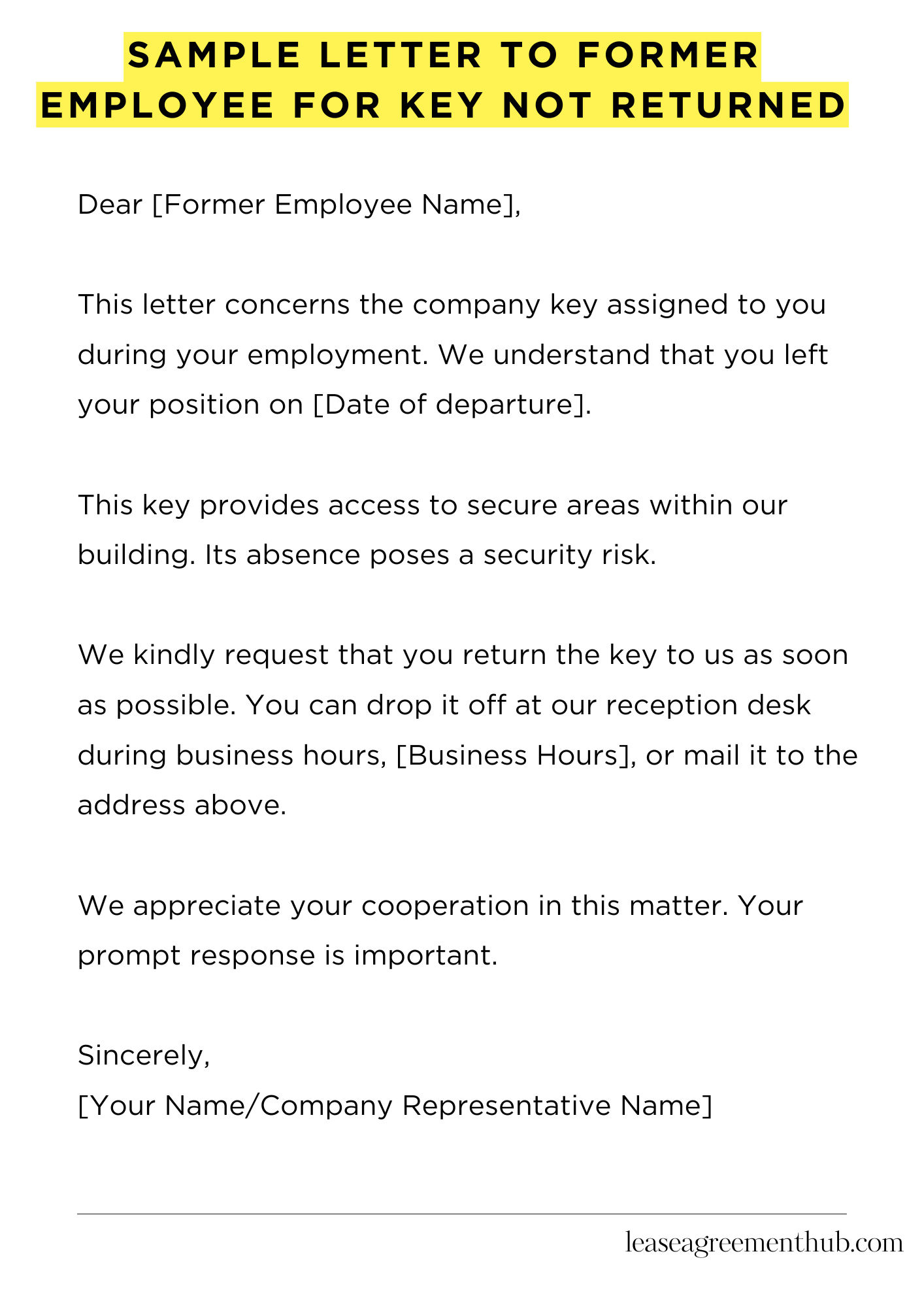Losing a key is frustrating. Especially a company key. This article helps with that.
We’ll give you sample letters. These are templates. They’re easy to adapt.
Use these examples. Write your own letter quickly. Get your key back easily.
sample letter to former employee for key not returned
[Your Company Letterhead]
[Date]
[Former Employee Name]
[Former Employee Address]
Dear [Former Employee Name],
This letter concerns the company key assigned to you during your employment. We understand that you left your position on [Date of departure]. However, the key has not yet been returned to us.
This key provides access to secure areas within our building. Its absence poses a security risk. We need to ensure the safety and security of our premises and its contents. Prompt return of the key is crucial.
We kindly request that you return the key to us as soon as possible. You can drop it off at our reception desk during business hours, [Business Hours], or mail it to the address above. Please ensure the key is securely packaged to avoid damage during transit.
If the key is already returned, please disregard this letter. However, if you have misplaced it, please let us know immediately. We may need to arrange for lock changes, which carries an associated cost.
We appreciate your cooperation in this matter. Your prompt response is important.
Sincerely,
[Your Name/Company Representative Name]

How to Write a Sample Letter to Former Employee for Key Not Returned
The Importance of a Formal Approach
Recovering company property is paramount. A nonchalant approach risks setting a detrimental precedent. Therefore, a formal letter, maintaining a professional yet assertive tone, is crucial. This ensures clarity and leaves a documented trail for future reference should the matter escalate.
Crafting the Salutation: Beyond the Generic
Avoid casual greetings. Instead, opt for a respectful yet firm salutation. “Dear [Former Employee’s Name],” suffices. Using their title, if known, adds a touch of formality, for example, “Dear Mr./Ms./Mx. [Last Name],” shows consideration for their professional standing.
Articulating the Problem: Precision and Clarity
Directly address the outstanding issue. Avoid ambiguity. Clearly state that a company key remains unreturned. The phrasing should be impeccably clear, leaving no room for misinterpretation. For instance, state definitively, “This letter pertains to the outstanding return of your company issued key, number [key number], which was assigned to you during your employment.”
Setting Expectations: A Firm but Fair Request
Specify a reasonable timeframe for the key’s return. Offer multiple options if possible. Do not be unduly aggressive, but be unambiguous about the repercussions of non-compliance. A sentence such as, “Kindly return the key by [date], either by mail to [address] or in person during business hours,” is both clear and polite.
Addressing Potential Objections: Proactive Mitigation
Anticipate possible reasons for non-return—loss, oversight, etc.—and address these preemptively. Suggest alternative solutions, such as replacing the key if it’s lost. This demonstrates fairness and fosters potential cooperation. This proactive approach mitigates potential conflict.
Concluding the Correspondence: A Definitive Close
Reinforce the importance of returning the key. Reiterate the deadline and the consequences of non-compliance. A closing such as, “We trust you will take immediate action to resolve this matter. Failure to comply may necessitate further action,” concludes the letter decisively.
Review and Revise Before Dispatch: The Final Polish
Proofread meticulously. Grammatical errors and typos undermine your professionalism. Ensure the tone is consistently formal, assertive, and respectful. A well-crafted letter reflects positively on your organization, even in less-than-ideal circumstances. Seek a second opinion before sending the letter; a fresh pair of eyes can catch oversights you might miss.
FAQs about sample letter to former employee for key not returned
Losing company property after an employee’s departure can be frustrating. A well-written letter can help resolve the situation efficiently.
What information should be included in the letter?
The letter should clearly state the employee’s name, their former position, the specific key(s) missing, and the date of their last employment. It should politely request the return of the key(s) and specify a reasonable timeframe for return. Include contact information for follow-up. Consider mentioning any consequences of non-return (e.g., potential security concerns, further action).
What tone should the letter adopt?
Maintain a professional and courteous tone throughout the letter. While firm in your request, avoid accusatory language. A polite and respectful approach is more likely to achieve a positive outcome. It’s essential to prioritize a collaborative resolution rather than an adversarial one.
What if the former employee doesn’t respond?
If the former employee fails to respond within the specified timeframe, a follow-up letter or phone call might be necessary. Document all attempts to contact the former employee. If the key remains unreturned, you may need to consult with legal counsel or your company’s security department to determine further action based on your company’s policies.
Should I mention the cost of replacing the key?
While not mandatory in the initial letter, mentioning the cost of replacing the key or associated security measures can be a helpful incentive. This highlights the financial implications of non-return and reinforces the importance of the key’s return. However, avoid an overly threatening tone when discussing potential costs.
Is it necessary to send the letter via certified mail?
While not always required, sending the letter via certified mail with return receipt requested provides documented proof that the letter was received. This is particularly helpful if further action becomes necessary. It establishes a record of your attempts to resolve the issue amicably before escalating the situation.
Related: